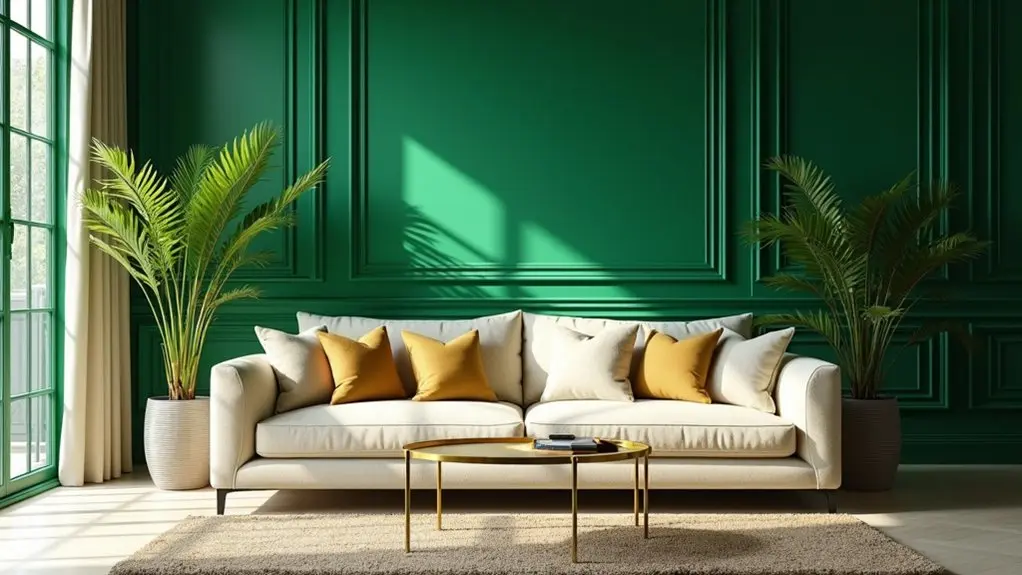
18 Green Living Room Walls That Make a Statement With Style
Green living room walls make a statement with versatility and style, from serene soft sage and pastel hues to dramatic emerald or forest green. Design techniques like monochrome layering, two-tone wall treatments, and sophisticated paneling enhance architectural interest. Pairings with natural textures, bold patterns, and organic wood tones create balanced, visually rich spaces. Plush velvet sofas and curated accessories infuse depth and materiality. Discover how nuanced color choices and thoughtful styling strategies uplift any living room’s ambiance.
Key Takeaways
- Deep emerald or forest green walls create dramatic, sophisticated focal points and pair beautifully with lighter furnishings for high-impact contrast.
- Soft sage and pastel green walls foster a calming, serene atmosphere while harmonizing with warm neutrals and organic wood accents.
- Layered textures—like velvet cushions, natural wood, and indoor plants—enhance the richness and botanical character of green living room walls.
- Two-tone green walls or green paneling techniques add architectural interest, depth, and tailored ambiance to living spaces.
- Crisp green and white combinations amplify natural light, making rooms feel fresh, open, and visually dynamic.
Embracing Tranquility With Soft Sage Walls
Tranquility finds its visual counterpart in the gentle embrace of soft sage green walls, a hue celebrated for its restorative qualities and understated sophistication. This nuanced shade orchestrates a calming atmosphere, making it the quintessential backdrop for living spaces seeking serenity. Soft sage green seamlessly harmonizes with warm neutral palettes and organic wood accents, amplifying spatial warmth and textural depth. Integrating plush textiles—such as velvet cushions or linen drapery—enhances the room’s soothing ambiance, inviting tactile comfort and repose. Its chameleon-like adaptability complements a spectrum of design aesthetics, from modern minimalism to rustic charm or vintage refinement. Opting for eco-friendly soft sage green paint aligns environmental responsibility with improved décor, ensuring style and sustainability coalesce effortlessly in a timeless, tranquil retreat. Incorporating houseplants to balance the serene green walls can further enhance the natural and calming atmosphere of the room.
Dramatic Impact of Deep Emerald Green
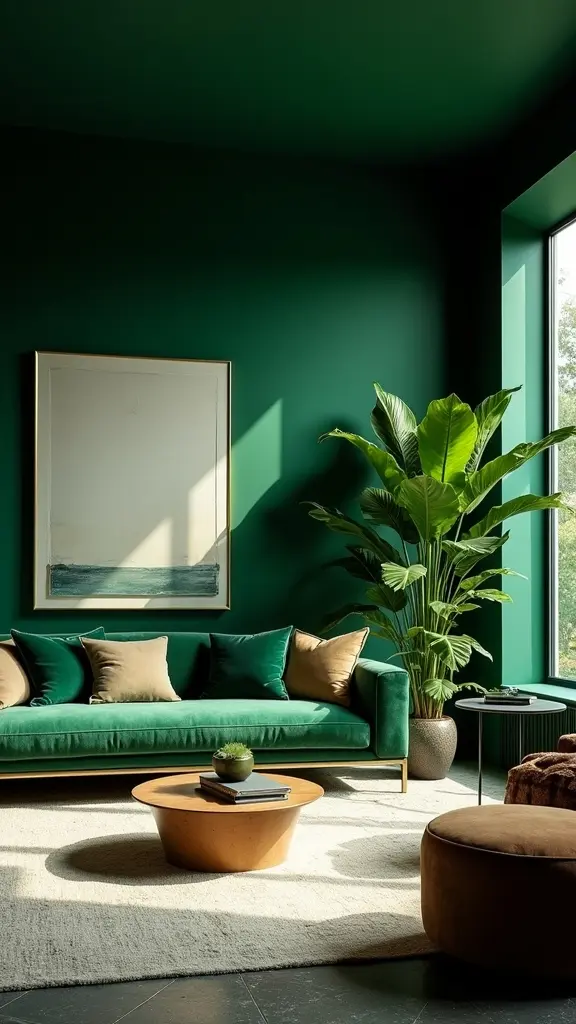
While soft sage green envelopes a living room in gentle serenity, deep emerald green offers an entirely different visual narrative—one defined by boldness and opulence.
This dark green living room palette transforms walls into a dramatic canvas, instantly infusing sophistication and depth. Emerald green’s lush saturation, especially when illuminated by natural light, accentuates architectural details and creates a sense of grandeur. Incorporating warm greens like forest green enhances coziness and connects to nature, transforming spaces into tranquil havens.
Paired with lighter furnishings and metallic accents, the hue delivers striking contrast, while wood tones and neutrals provide harmonious balance. For homeowners seeking a statement that marries elegance with tranquility, emerald green is a compelling solution.
- Instantly enhances interiors with rich, jewel-toned drama.
- Fosters emotional calm, balancing boldness with serenity.
- Offers versatile styling potential across contemporary and classic aesthetics.
Light and Airy Spaces With Pastel Green
A serene pastel green palette infuses living rooms with a sense of openness and tranquility, particularly effective in compact or naturally dim spaces.
By strategically utilizing light green hues, homeowners can amplify natural brightness and foster a calming visual harmony.
Combining pastel green walls with crisp white accents further enhances luminosity, crafting an interior that feels both fresh and restorative.
Serene Pastel Green Palette
Soft pastel green palettes offer an immediate sense of visual spaciousness, infusing living rooms with luminosity and subtle sophistication.
This soothing hue acts as a transformative foundation, enveloping spaces in a delicate lightness that enhances both serenity and style.
Pastel green, when paired with crisp white or gentle cream accents, enhances interiors by creating a harmonious and tranquil backdrop adaptable to diverse décor themes.
The result is an environment that feels both open and rejuvenating, ideal for intimate gatherings or peaceful solitude.
- Tranquility Revealed: Pastel green walls evoke a calming sanctuary, easing the mind and inviting relaxation.
- Aesthetic Harmony: Soft green palettes seamlessly integrate with modern and vintage design elements.
- Elevated Brilliance: This color solution amplifies natural brightness, making compact or shadowed living rooms feel expansive and inviting.
Enhancing Light With Color
How does one craft a living room that feels both luminous and tranquil? The strategic use of light green on the walls offers a sophisticated solution.
Pastel green shades reflect natural light, amplifying brightness and lending an expansive quality even to compact or dimly lit spaces. This chromatic choice introduces a revitalizing ambiance, subtly invigorating yet fundamentally serene.
Light green avoids overwhelming the senses, instead providing a gentle wash of color that soothes and rejuvenates. For a cohesive aesthetic, these green shades pair effortlessly with warm neutrals and organic wood accents, promoting visual harmony and inviting warmth.
At its core, pastel green walls serve as an elegant backdrop, enhancing light while preserving a calm, airy atmosphere—perfect for contemporary living rooms seeking both style and tranquility.
Botanical Influence: Bringing Nature Indoors
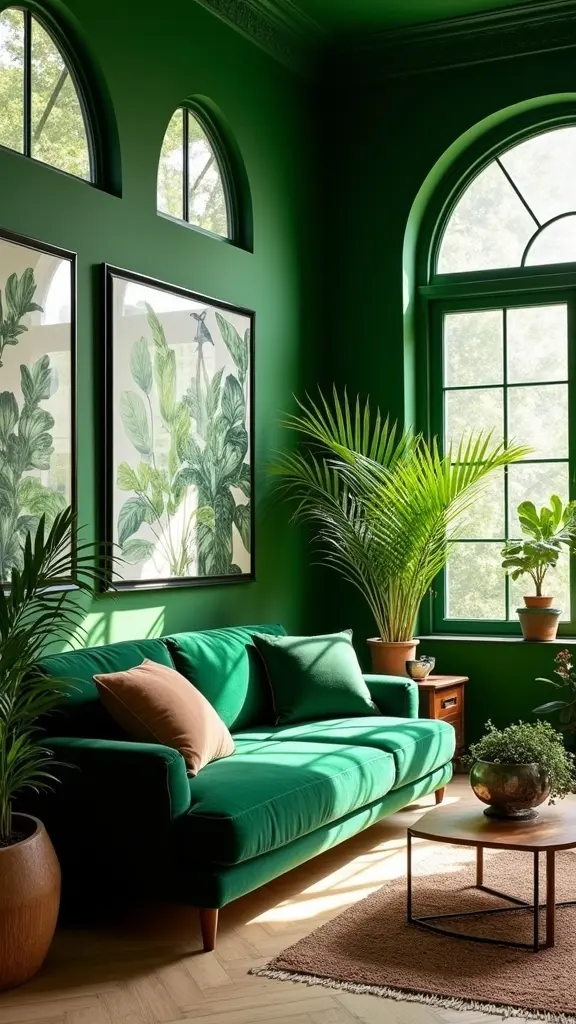
A living room infused with botanical influence achieves visual serenity by integrating verdant wall hues, abundant indoor foliage, and organic materials. The strategic use of natural textures—such as jute rugs and rattan accents—alongside wood furnishings, establishes a tactile dialogue with the outdoors. Harmonizing green tones with wood elements creates a cohesive, biophilic sanctuary that supports both relaxation and aesthetic sophistication. Adding plants like the Begonia Maculata enhances the aesthetic appeal with its striking polka-dotted leaves, contributing to a serene and stylish environment.
Embracing Indoor Plant Life
Infusing a green living room with indoor plant life enhances the space’s botanical character, seamlessly blending natural elements with curated design.
Lush indoor plants—such as ferns, snake plants, and pothos—introduce dynamic textures and a spectrum of green accents that amplify the vibrancy of verdant walls.
By incorporating plant stands or hanging planters, one can strategically raise foliage, guiding the gaze upward and crafting an immersive, multi-layered environment.
The resulting synergy fosters tranquility, purifies the air, and reinforces a restorative connection to nature within the home.
- Witness the soothing interplay of layered greens, where living foliage echoes wall tones for a harmonious sanctuary.
- Experience serenity as natural greenery transforms the living room into a retreat of botanical elegance.
- Delight in the rejuvenating ambiance shaped by thriving indoor plants and expressive green accents.
Natural Textures and Tones
Texture becomes the cornerstone of a botanically inspired living room, where green walls serve as a vivid backdrop for the interplay of natural materials.
Layering natural textures—such as jute rugs, rattan accents, and clay vessels—infuses the space with tactile richness and visual depth. Earthy tones, woven through decorative accessories and textiles, ground the verdant palette, enhancing the organic ambiance without overwhelming the senses.
Crisp apple green walls, when punctuated with fuchsia accents, introduce a dynamic yet cohesive contrast that remains true to the botanical theme. The strategic use of lush indoor plants amplifies the sense of liveliness, reinforcing the connection to nature.
This approach fosters a harmonious sanctuary, blending varied textures and subdued neutrals for a balanced, restorative environment.
Harmonizing Green and Wood
Building upon the interplay of natural textures, the integration of wood elements alongside green living room walls deepens the space’s botanical character.
The juxtaposition of green walls with natural wood tones delivers a harmonious aesthetic, drawing inspiration from forest scenery and tranquil gardens. Textured wood finishes, whether in furniture or architectural details, introduce tactile warmth and visual contrast that raises soothing greens—especially sage or olive—to new levels of serenity.
Layering lush indoor plants further amplifies the organic narrative, blurring boundaries between interior and nature. For those seeking a cohesive, solution-oriented design, the following evoke a sense of calm and authenticity:
- Light wood accents paired with sage green walls inspire tranquility.
- Textured oak or walnut enhances depth and visual intrigue.
- Large potted plants invigorate the botanical ambiance.
Sophisticated Monochrome Green Schemes
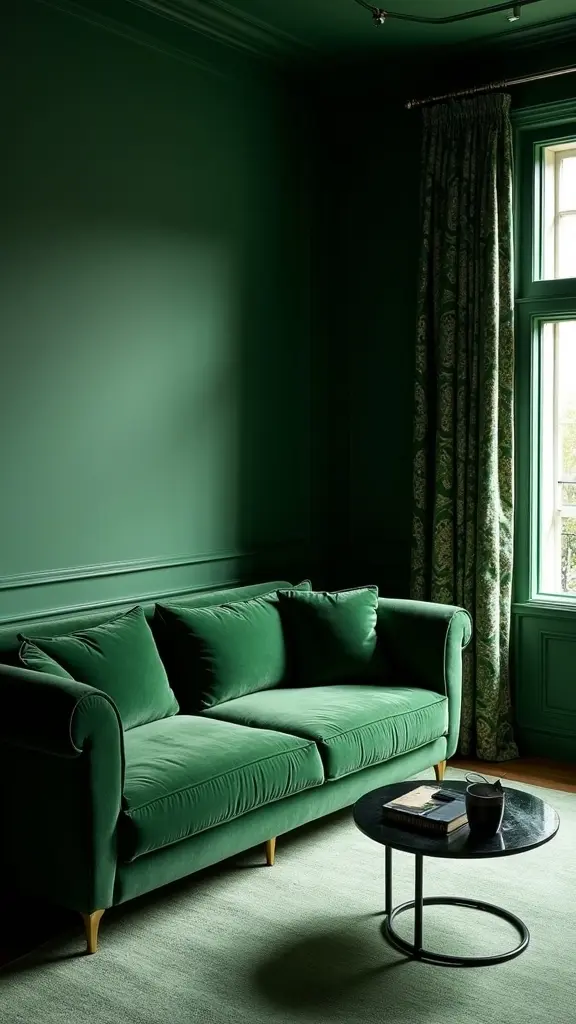
While a single color might seem limiting, a sophisticated monochrome green scheme leverages a spectrum of verdant hues to produce depth and cohesion within the living room.
By layering dark emerald walls with lighter sage or moss accents, designers introduce nuanced visual interest and a sense of architectural dimension.
The interplay of textured fabrics—such as velvet cushions or linen throws—paired with wood accents and metallic finishes, further amplifies the elegance of the monochrome palette.
This curated approach guarantees depth to the space, preventing monotony while sustaining a harmonious aesthetic.
Strategic use of accessories, like artwork or ceramics in complementary green tones, subtly enriches the overall scheme.
Incorporating patterns and varying tactile surfaces keeps the design dynamic, resulting in a living room that feels refined and inviting.
A green accent wall can be paired with blush pinks, deep blues, and golds to enhance its visual appeal and create a cohesive color palette throughout the space.
Retro Revival With Olive and Avocado Hues
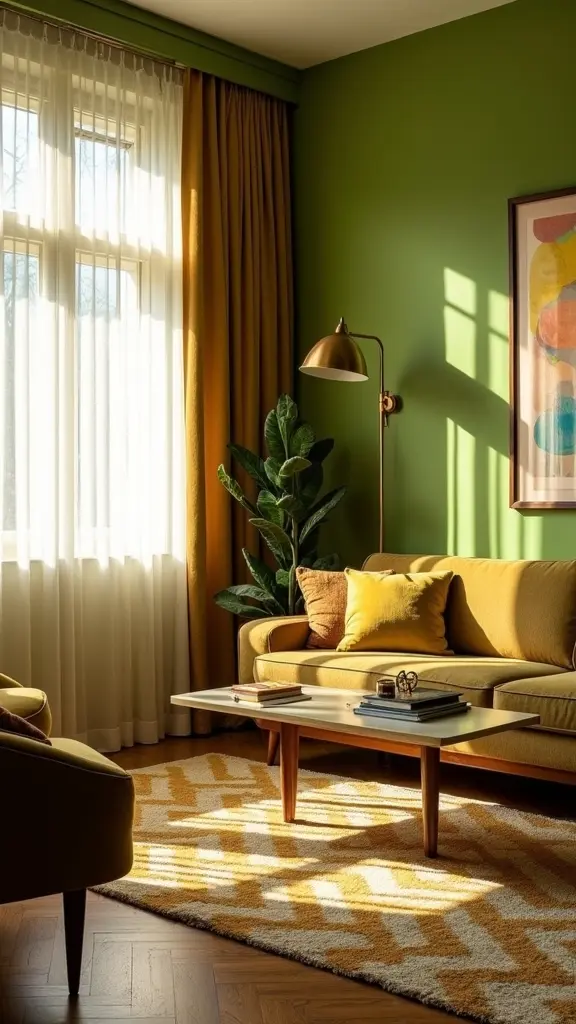
A retro revival emerges through the judicious use of olive and avocado hues, bringing classic 70s green tones into a contemporary context.
By integrating these shades with warm undertones and tactile materials, designers can curate inviting palettes that bridge nostalgia and modernity.
Thoughtful layering of vintage-inspired accents, statement furniture, and geometric patterns offers a visually engaging solution for those seeking to modernize their living room’s retro charm.
Modernizing Vintage Green Tones
Few color palettes capture the essence of retro revival as effectively as the resurgence of olive and avocado green hues in modern living rooms.
These tones bridge nostalgia and innovation, offering a sophisticated yet approachable aesthetic. Olive green walls, especially with matte finishes, provide a serene backdrop that accentuates the sculptural lines and textures of vintage furniture.
The careful balance of old and new is further refined by layering in metallic accessories, infusing the space with a heightened, curated energy.
- Nostalgic Warmth: Olive green envelops the space in a comforting embrace, stirring memories of mid-century design.
- Curated Character: Vintage furniture against vintage green walls fosters a uniquely expressive and harmonious atmosphere.
- Modern Sophistication: Matte finishes and metallic accents modernize these classic hues, creating a timeless and inviting living room.
Pairing With Warm Accents
Retro vibrancy emerges in living rooms where olive and avocado green walls serve as a canvas for warm accentuation. These mid-century hues, when paired with terracotta, mustard yellow, and warm pinks, evoke a sophisticated nostalgia while infusing the space with contemporary comfort. Olive green walls, complemented by vintage furnishings and earthy textures, introduce visual layering and tactile depth. The interplay between retro greens and warm accents creates an inviting, harmonious environment, further enriched by warm wood grains and curated accessories.
| Element | Effect on Atmosphere |
|---|---|
| Olive Green Walls | Retro foundation, serene backdrop |
| Warm Pinks | Soft contrast, lively undertone |
| Terracotta Accents | Earthy warmth, grounded energy |
| Mustard/Burnt Orange | Playful pop, cohesive retro palette |
This pairing maximizes stylistic cohesion and welcoming ambiance.
Retro-Inspired Decor Ideas
Building on the warmth of vintage-inspired accents, retro decor ideas harness the evocative power of olive and avocado green walls to craft interiors that are both nostalgic and invigoratingly modern.
Olive green, as a wall color, creates a grounded backdrop, seamlessly integrating with mid-century furnishings and bold patterns characteristic of retro-inspired decor. Accents in dusty pink or terracotta infuse vibrancy, while floor-to-ceiling curtains in plush fabrics highlight vertical space, adding drama and sophistication.
Accessories such as antique artwork and patterned rugs underscore the retro revival, ensuring a personalized yet cohesive aesthetic.
- Layer vintage furniture with textured throws and cushions for depth and comfort.
- Incorporate bold, geometric rugs to anchor the olive green palette and evoke retro flair.
- Display curated antique art to celebrate the era’s unique design language.
Pairing Green Walls With Bold Patterns

When thoughtfully executed, pairing green living room walls with bold patterns enhances the space by balancing visual intrigue with a sense of tranquility.
Deep forest green walls provide a serene backdrop for patterned designs, whether geometric, botanical, or abstract, ensuring that the room feels dynamic yet cohesive.
Patterned textiles—such as cushions, throws, or curtains in vibrant hues—introduce visual rhythm while complementing the green palette.
For maximalists, layering wallpapers or artwork featuring bold motifs on green walls cultivates a spirited yet curated atmosphere, where color and texture coexist harmoniously.
Strategic placement of patterns prevents visual overload, allowing green walls to anchor the space.
Ultimately, this approach delivers a sophisticated interplay between calming green tones and statement-making patterns, blending modernity with natural elegance.
Accentuating With Green and Wood Tones
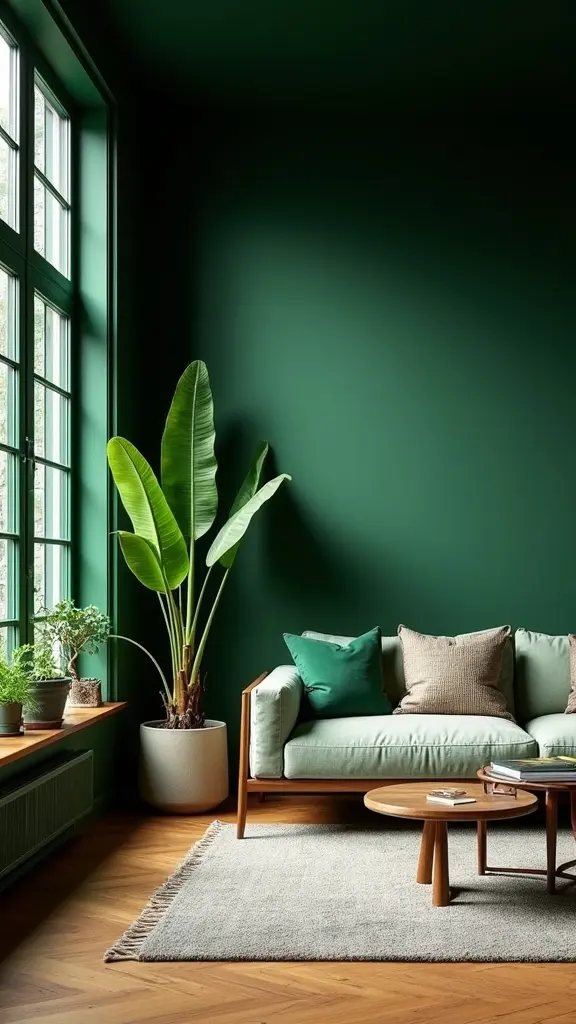
While green living room walls already evoke a sense of tranquility, their visual impact is enhanced through the intentional introduction of wood tones.
This pairing creates a harmonious balance, where the natural warmth of wood allows green walls to emerge as a mesmerizing focal point.
Textured wood finishes—such as reclaimed beams or raw shelving—amplify the organic ambiance, enveloping the space in coziness and authenticity.
When dark green walls are contrasted with lighter wood tones, the result is a striking interplay of depth and sophistication.
Wooden furniture seamlessly integrates nature-inspired aesthetics, reinforcing the room’s calming and cohesive design.
Terracotta accents add depth and an earthy atmosphere, enhancing visual appeal.
- Experience the embrace of nature with every glance.
- Revel in the interplay of warmth and serenity.
- Transform ordinary living rooms into inviting sanctuaries.
Creating Intimacy With Dark Green Ceilings
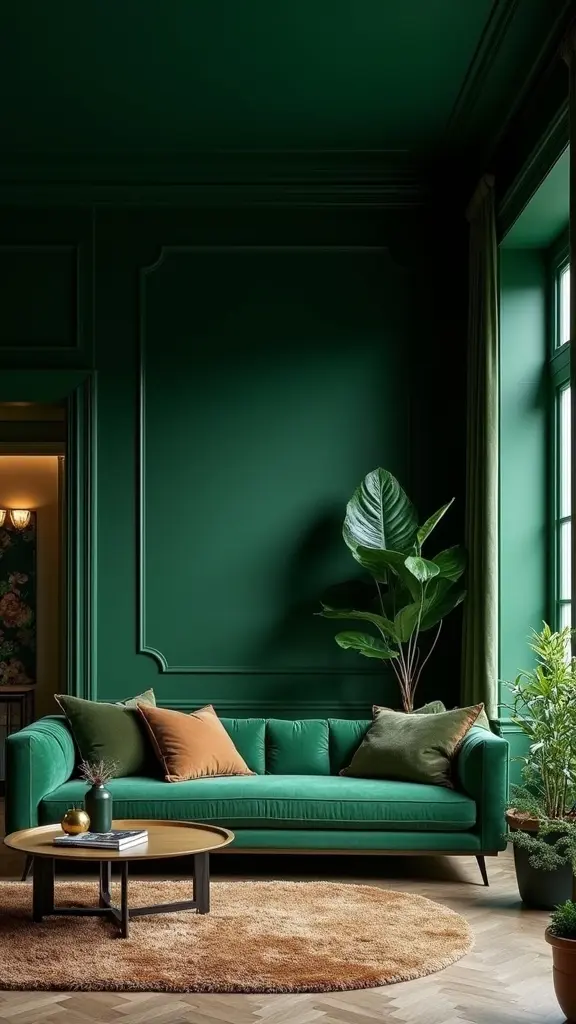
Extending the natural harmony of green walls and wood, designers often look upward to explore the transformative potential of dark green ceilings. Applying dark green paint—such as Studio Green or Calke Green—elevates a living room’s ambiance, creating a relaxing, cocoon-like effect even in expansive spaces. This chromatic approach visually recedes the ceiling, enveloping the room in intimacy and warmth. The interplay between a rich, dark ceiling and lighter walls not only draws the eye upward but also establishes an intentional design focal point while maintaining equilibrium. When abundant natural light enters, the deep green ceiling absorbs and softens the illumination, preventing gloom and enhancing architectural details. The result is a sophisticated, enveloping space where relaxation and style seamlessly coexist. Incorporating metallic accents, such as frames, can enhance the elegance and depth of the space, creating a cohesive and sophisticated look.
Freshness With Crisp Green and White Combos
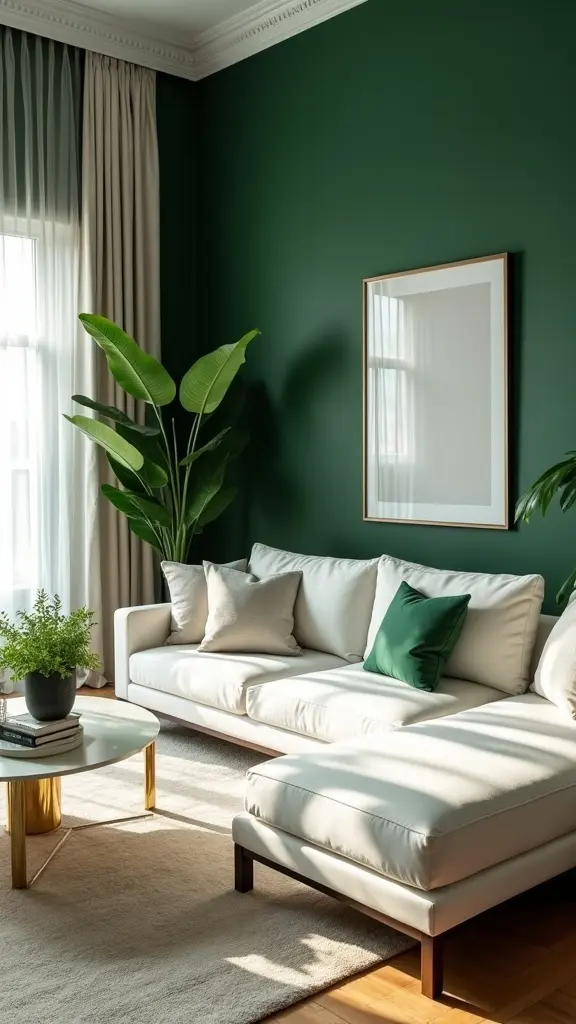
A crisp interplay of green and white instantly amplifies natural light, imparting a breezy spaciousness to the living room. Strategic use of white walls with green accents, or modern botanical pairings, creates a balanced palette that feels both invigorating and serene. Utilizing contrast between these hues not only enhances illumination but also offers a versatile backdrop for layered textures and curated accessories. To elevate the aesthetic appeal, consider incorporating metallic lighting fixtures and warm brass finishes to create a stylish and sophisticated environment.
White Walls, Green Accents
Elevating a living room’s aesthetic, white walls serve as an immaculate canvas that amplifies the vibrancy of green accents, resulting in a space that feels both invigorating and tranquil.
The interplay between crisp white and nuanced green elements—be it plush cushions, botanical artwork, or verdant foliage—delivers visual freshness and a sense of organic calm.
Varying the shades of green, from airy mint to rich forest, injects depth without sacrificing cohesion.
This approach not only enhances spatial luminosity but also allows for effortless seasonal shifts by updating green accessories.
The sophisticated contrast between white walls and green accents offers a timeless yet flexible design solution.
- A luminous sanctuary evoking clarity and renewal
- Nature-infused serenity through dynamic green layers
- Effortless adaptability for evolving personal style
Modern Botanical Pairings
Within the sphere of contemporary design, modern botanical pairings harness the invigorating interplay of crisp green walls and white accents to cultivate spaces that exude freshness and spatial clarity.
This chromatic duo transforms living rooms into tranquil sanctuaries, where vibrant green walls anchor the aesthetic and white elements amplify perceived brightness and openness. The incorporation of indoor plants furthers the modern botanical ethos, introducing organic energy and reinforcing the visual narrative of rejuvenation.
Strategically selected light green hues, when juxtaposed with minimalist white furnishings, expand compact or dimly lit spaces, optimizing both functionality and ambiance.
This approach supports versatile layering of textures—think natural wood, woven textiles, and plush upholstery—seamlessly integrating with the green-and-white palette for a cohesive, solution-oriented design statement.
Enhancing Light With Contrast
Luminosity becomes a defining element when crisp green walls are juxtaposed with pure white accents, orchestrating a visual dialogue that enhances both freshness and spatial clarity.
This interplay not only boosts ambient light but also cultivates an airy, rejuvenating atmosphere—especially beneficial in compact or low-light living rooms.
By integrating white accents through trim, ceilings, or streamlined furniture, the green walls are visually uplifted, accentuating architectural contours and infusing modern sophistication.
The clean, versatile palette also accommodates textural exploration and subtle layering, inviting tactile comfort without visual heaviness.
- Inviting Serenity: The union of green walls and white accents evokes a sense of calm, ideal for relaxation and unwinding.
- Spatial Illumination: This contrast visually expands interiors, making rooms appear larger and more radiant.
- Architectural Emphasis: White details highlight moldings and frameworks, adding expressive depth to the space.
Modern Minimalism Using Muted Greens
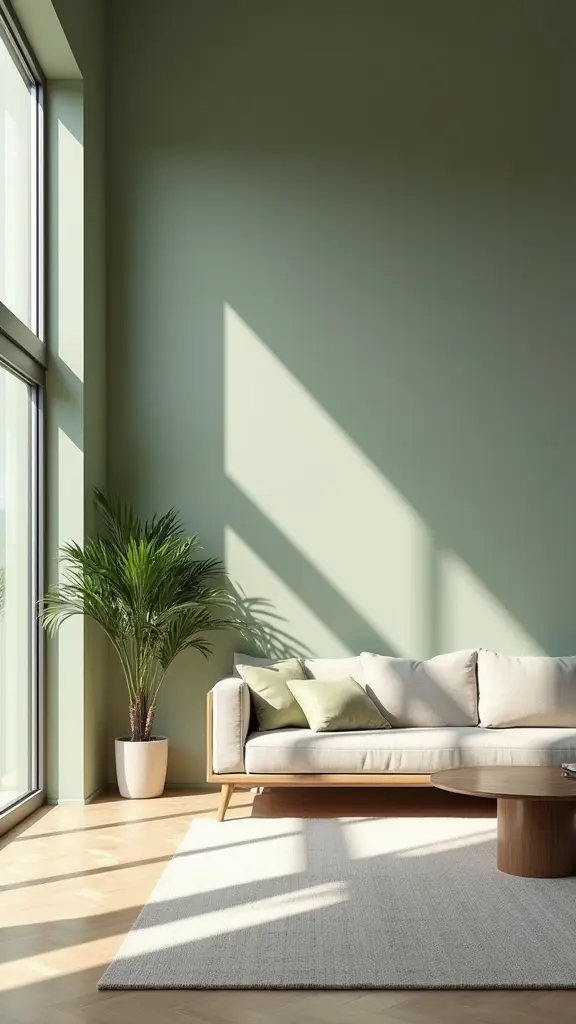
How can one achieve a tranquil yet visually compelling living space? In modern minimalism, muted greens—such as soft sage or nuanced grey-green—provide a serene canvas that enhances calm and cohesion. These understated hues reflect natural light, cultivating an airy ambiance while seamlessly uniting with organic materials like wood and stone for subtle warmth and tactile interest. Muted greens support a solution-oriented approach: they harmonize with neutral furnishings and discreet accents, ensuring visual clarity without sensory overload. The result is a living room that radiates equilibrium and quiet sophistication. Incorporating natural elements such as houseplants and wooden accents can further enhance the warm and cozy minimalist aesthetic by adding texture and depth.
| Element | Effect on Space |
|---|---|
| Soft sage walls | Gentle, restful backdrop |
| Grey-green accents | Understated elegance |
| Natural wood furniture | Warmth and organic texture |
| Stone accessories | Earthy, minimalist contrast |
| Neutral textiles | Cohesive, balanced aesthetic |
Scandinavian Style: Greens and Neutrals
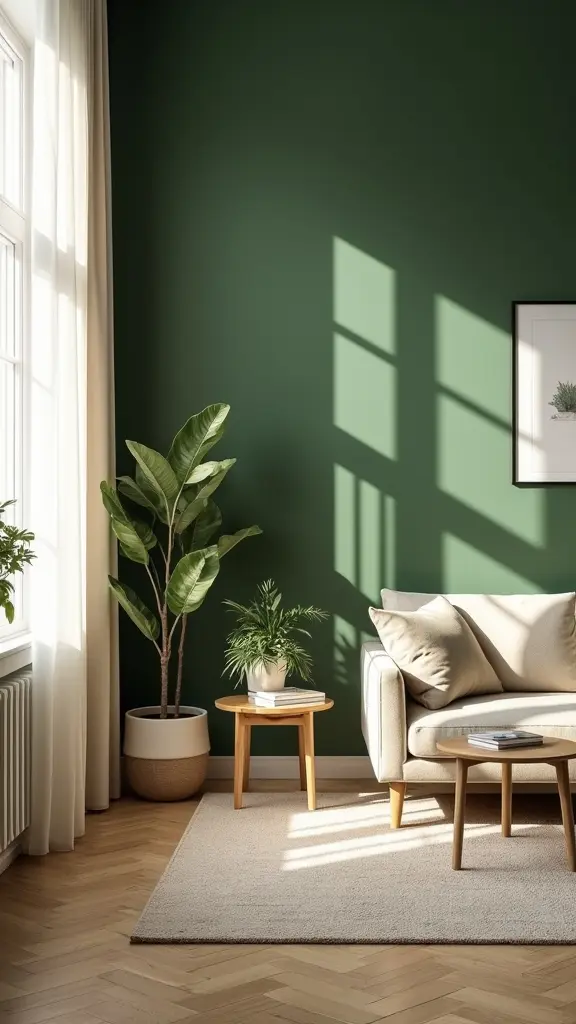
While Scandinavian interiors are renowned for their luminous simplicity, the thoughtful application of green and neutral palettes enhances this style to new heights of serenity.
Soft green tones paired with creamy neutrals and biscuit hues cultivate a harmonious visual rhythm, ideal for fostering a light, tranquil atmosphere. Lightweight furniture in verdant shades raises the modern edge without sacrificing the signature minimalism.
Organic elements—like broad-leafed plants and natural woods—infuse freshness, while textured finishes such as jute and rattan add tactile warmth. Incorporating natural materials like stone or distressed wood can further elevate the room’s inviting atmosphere.
Combining varying green tones with neutral colors creates a calming, cohesive environment that embodies Scandinavian restraint and comfort.
- Soft green walls bathed in natural light evoke tranquility.
- Neutral colors and wood accents ground the space in warmth.
- Lush botanicals heighten the room’s organic, restful vibe.
Statement Gallery Walls on Green Backdrops
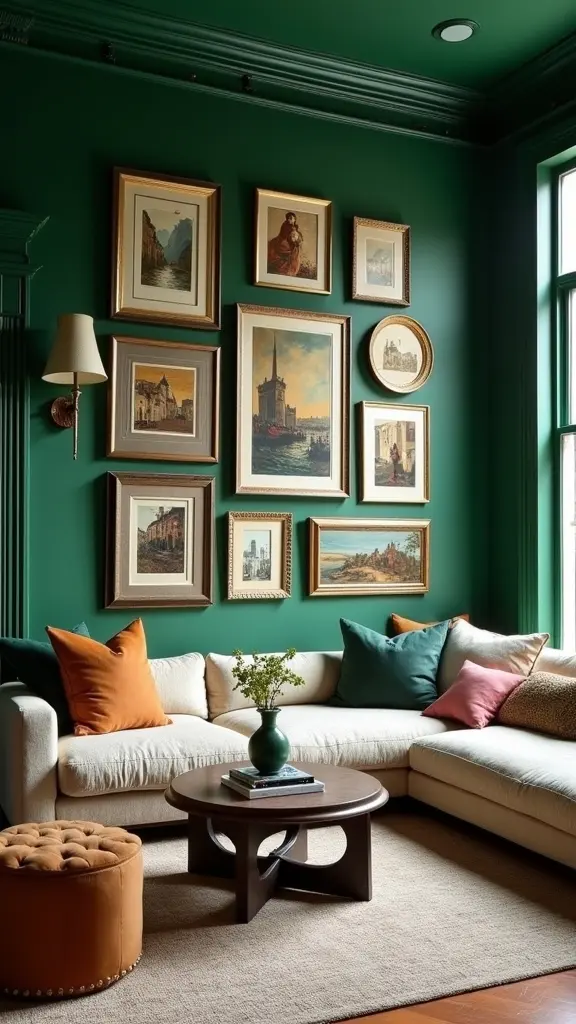
A statement gallery wall set against green living room walls establishes a striking focal point, seamlessly merging visual intrigue with curated sophistication. The interplay between a gallery wall and a lush green backdrop amplifies artwork, letting each piece command attention while harmonizing with the room’s palette. Selecting frames in light and dark woods introduces dimensionality and bold contrast. Metallic accents—brass, gold, or chrome—add a layer of refinement, transforming the gallery wall into a chic, gallery-inspired installation. Artwork featuring complementary hues like soft pinks or warm neutrals fosters visual cohesion, balancing vibrancy with serenity. The result is a dynamic narrative woven into the space, showcasing creativity and personal style. Incorporating oversized mirrors can enhance the depth and focal point of the living room, complementing the gallery wall and green backdrop with added visual interest.
Green Velvet Sofas as Focal Points
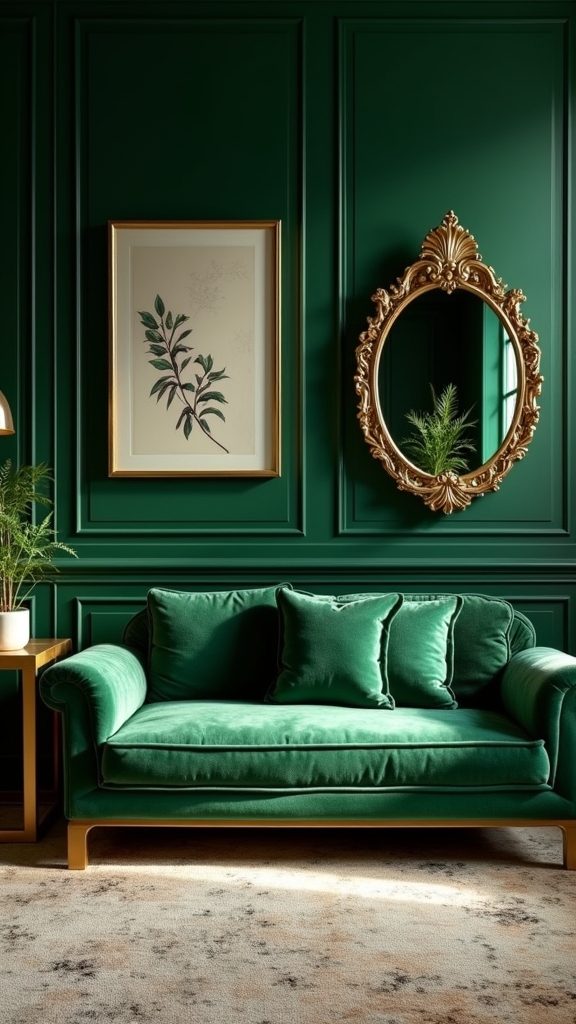
Building on the visual impact of statement gallery walls, green velvet sofas introduce a tactile centerpiece that anchors the living room with luxurious depth.
Their plush upholstery and saturated color become a bold yet harmonious partner to green wall shades, fostering a sense of tranquility and refined sophistication.
Green velvet sofas effortlessly bridge modern and traditional aesthetics, offering versatility in styling through accent pillows and curated accessories.
With their adaptable charm, green velvet sofas unite classic and contemporary styles, inviting endless possibilities with thoughtful accents and accessories.
The interplay of texture and tone not only enhances the room but also encourages the incorporation of botanical elements, enhancing a serene, nature-inspired ambiance.
- Serenity: Green velvet sofas paired with green wall shades evoke a calming, restorative environment.
- Elegance: The opulent texture creates a sense of high design and timeless appeal.
- Versatility: Easily accessorized, these sofas adapt to evolving décor preferences.
Dynamic Spaces With Two-Tone Green Walls
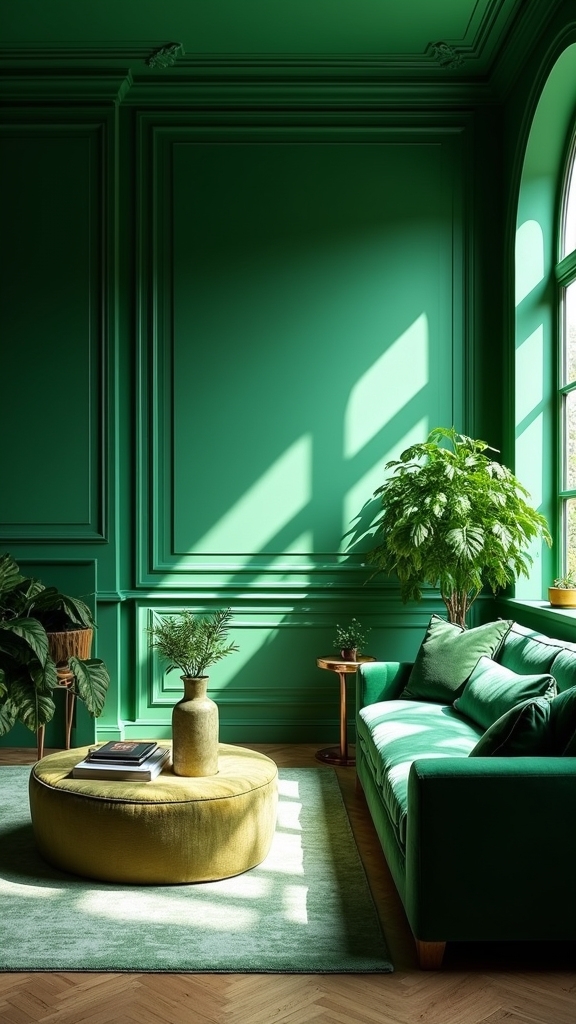
Through the strategic use of two-tone green walls, living rooms gain both architectural interest and tailored ambiance, as nuanced color shifts sculpt the perception of space.
By layering a lighter shade of green above a deeper tone, interiors achieve an illusion of heightened ceilings, simultaneously imparting elegance and visual intrigue. This chromatic division enhances depth, while the interplay of shades of green fosters a sense of movement and energy within the room.
Contrasting wood accents—whether in trim or carefully curated furniture—further accentuate the richness of the palette, introducing a warm, organic counterpoint.
Two-tone green walls are a solution-driven approach for delineating zones in open-plan layouts, offering homeowners the flexibility to personalize color combinations without sacrificing cohesion or sophistication.
Layering Green With Textures and Accessories
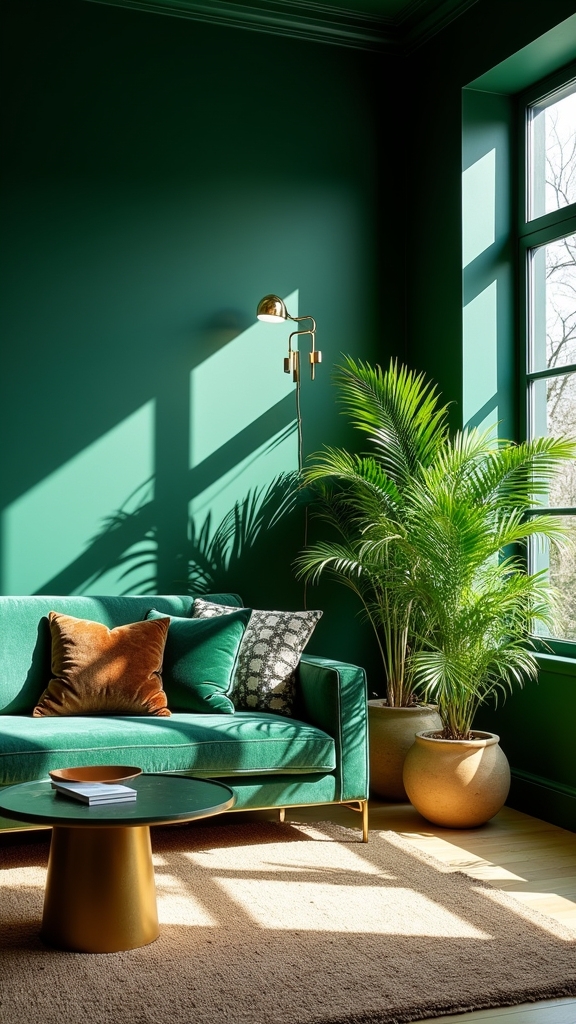
While two-tone green walls introduce chromatic dimension, the full potential of a green living room emerges when color is artfully balanced with texture and accessorization.
Layering different textures—such as tactile velvets, raw wood, and lustrous metals—amplifies visual intrigue and curates a dynamic, inviting sanctuary.
Strategic green living room ideas include incorporating accessories like tonal cushions, rugs, and curated art in varying green hues, establishing depth and cohesion.
Textured finishes—matte juxtaposed with gloss—invite light play, intensifying the verdant palette’s allure.
For a nuanced ambiance, consider:
- Plush textiles and patterned fabrics for comfort and sophistication.
- Decorative indoor plants in artisanal pots to infuse organic vibrancy.
- Mixed media artwork and metallic accents for added complexity and modernity.
Such thoughtful layering enhances any green living room.
Eclectic Style Using Custom Green Shades
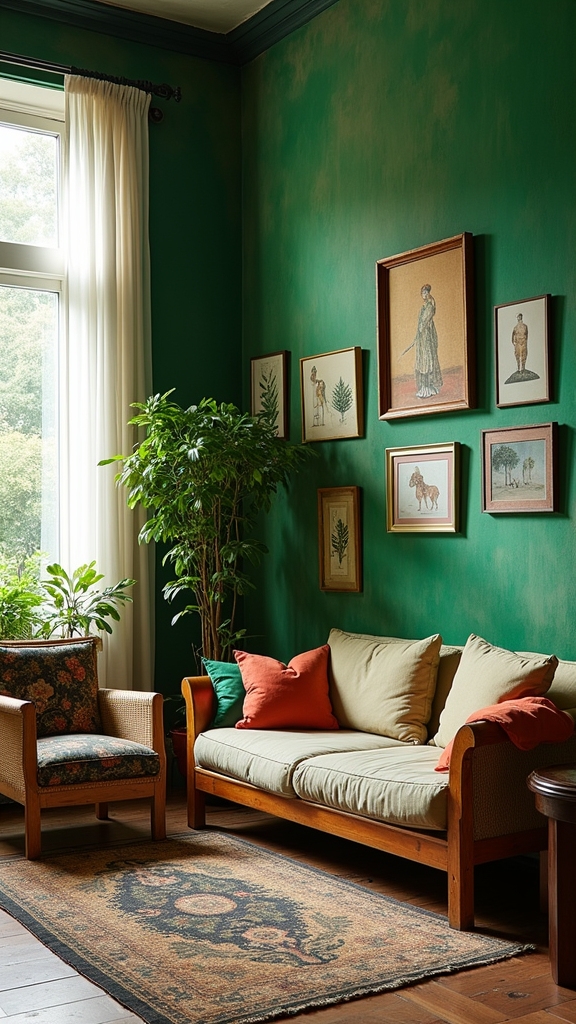
A myriad of custom green shades—ranging from the enigmatic “Invisible Green” to the vibrant “Breakfast Room Green”—serves as the chromatic foundation for an eclectic living room, imparting a curated sense of individuality and sophistication. These nuanced hues facilitate the seamless integration of vintage and modern decor, establishing a cozy yet enhanced atmosphere. By juxtaposing bold and subdued tones, the eclectic style gains visual dynamism and energy, ensuring a lively and inviting environment. Personal collections of art and artifacts find an ideal backdrop in custom green shades, contributing personality and depth. Additionally, these greens harmonize effortlessly with diverse textures—woven fabrics, rich woods—offering a cohesive yet layered aesthetic. The table below illustrates key components for crafting an eclectic living room with custom green shades:
| Green Shade | Main Texture | Decor Accent |
|---|---|---|
| Invisible Green | Woven Linen | Vintage Paintings |
| Breakfast Room Green | Polished Wood | Modern Sculptures |
| Custom Sage | Velvet Upholstery | Bohemian Ceramics |
Enhancing Light and Shadow With Green Paneling
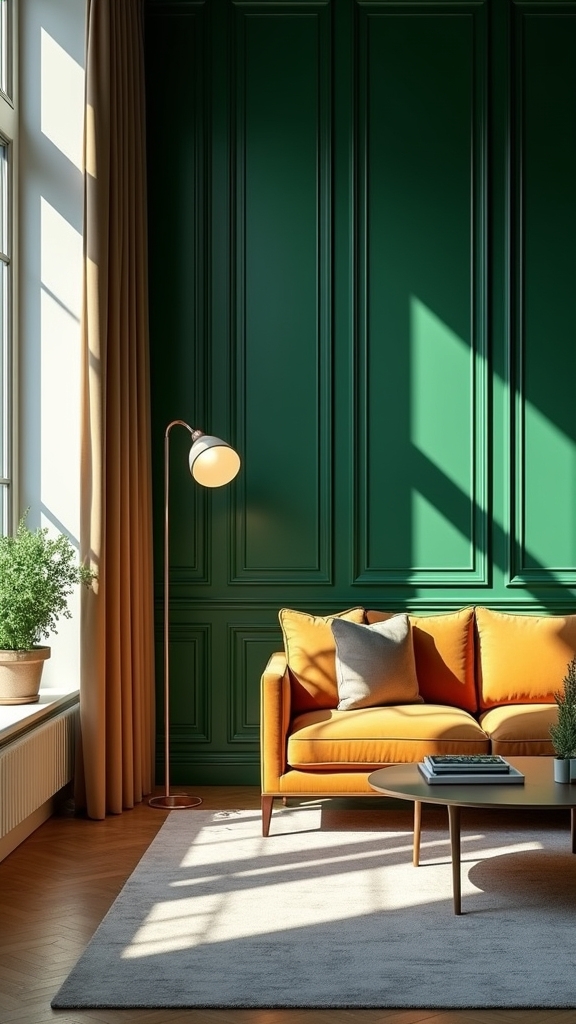
Strategically applied green paneling transforms living room walls into surfaces where light and shadow interplay, amplifying spatial depth and visual intrigue.
Subtle variations in hue and finish, such as glazed or lacquered treatments, accentuate architectural features and moldings by creating nuanced shadow lines.
This approach not only enriches texture but also offers a tailored solution for highlighting room geometry and enhancing overall ambiance.
Creating Depth With Shadows
By harnessing the interplay of light and shadow through green wall paneling, interior designers can cultivate a sense of depth that transforms a living room into a visually textured retreat.
The nuanced use of green paneling—ranging from pastel to deep forest hues—creates dynamic light shadows, amplifying the perception of space and dimension. Glossy or lacquered green finishes reflect natural light, casting subtle gradients and enriching the room’s ambiance.
Incorporating layered green tones in paneling not only enhances visual intrigue but also imbues the environment with warmth and character.
- The gentle gradation of light shadows evokes a sense of tranquility and comfort.
- Contrasting green tones inspire a mood of refined sophistication and drama.
- Sunlit reflections on green paneling foster an uplifting, radiant atmosphere.
Accentuating Architectural Details
Building upon the depth achieved through nuanced shadows, green wall paneling serves as a sophisticated tool for accentuating architectural features within a living room.
Light khaki green panelling delicately casts subtle shadows, tracing the contours of crown mouldings, wainscoting, or built-in shelving to enhance visual intrigue. The interplay of light and dark green hues can be strategically deployed to manipulate perceived spatial proportions, offering a tailored solution for making rooms feel either expansive or intimate.
Introducing a glazed finish on green wall panelling raises sunlight reflections, infusing the space with vibrancy while further highlighting architectural details.
For those seeking a dramatic effect, deep green tones paired with robust natural light emphasize structural lines, transforming arches, alcoves, or coffered ceilings into striking focal points within the living room.
Frequently Asked Questions
Are Green Living Room Walls Hard to Keep Clean?
The question of green living room wall cleanliness depends on finish and pigment intensity. Employing proper cleaning techniques and regular wall maintenance, such as gentle dusting and non-abrasive cleansers, preserves surface integrity and sustains an effortlessly curated, pristine aesthetic.
Do Green Walls Affect the Resale Value of a Home?
Resale trends indicate that wall color, influenced by color psychology, can impact buyer perception. Green walls, if harmoniously styled, may enhance spatial liveliness; however, excessively bold tones could limit broad appeal. Neutralizing hues often optimize resale potential.
Will Green Paint Fade Faster Than Other Colors?
The inquiry addresses whether green paint exhibits accelerated fading compared to other hues. Fading factors include pigment composition, sunlight exposure, and finish. For ideal color durability, selecting high-quality, UV-resistant paints guarantees the lasting vibrancy of green walls.
Can Green Walls Make a Room Feel Colder in Winter?
Green walls may evoke a cooler psychological perception due to green color psychology, potentially diminishing winter warmth. To counterbalance this effect, designers recommend layering tactile textiles, warm lighting, and wood accents for enhanced seasonal comfort and aesthetic harmony.
Are Certain Green Paints More Eco-Friendly or Non-Toxic?
When evaluating eco-friendly green paints, one should prioritize formulations utilizing natural pigments and low VOC options. These alternatives minimize off-gassing, enhance indoor air quality, and align with sustainable design principles, merging aesthetic appeal with health-conscious, environmentally responsible solutions.
Conclusion
Green living room walls offer a versatile canvas for aesthetic expression, from the serene elegance of sage to the bold drama of emerald. Whether layered through textured accessories or articulated with two-tone schemes and botanical motifs, green infuses spaces with both energy and sophistication. By thoughtfully selecting shades and finishes, homeowners can tailor light, shadow, and ambiance, crafting living rooms that are not only visually compelling but also harmonious sanctuaries attuned to both style and well-being.
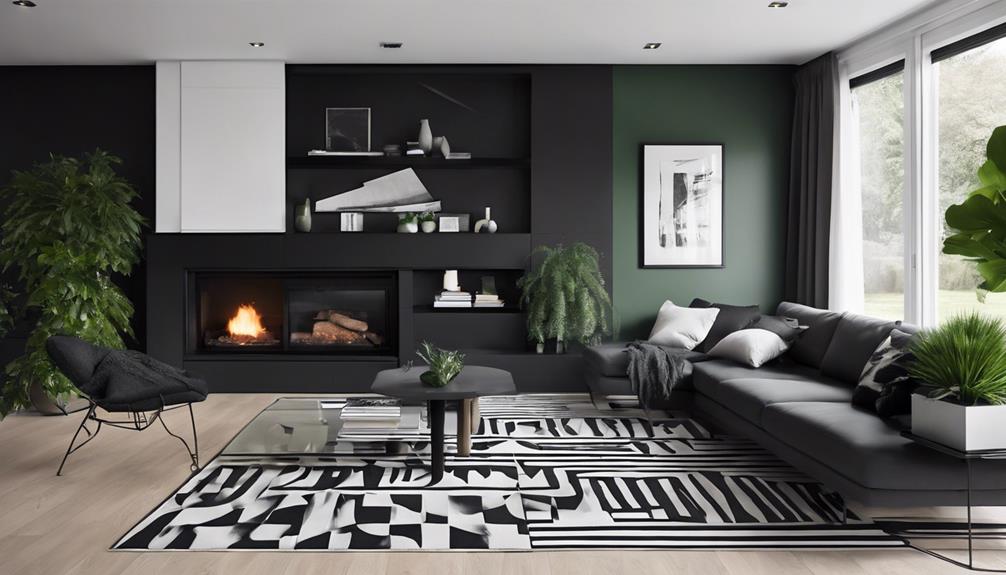
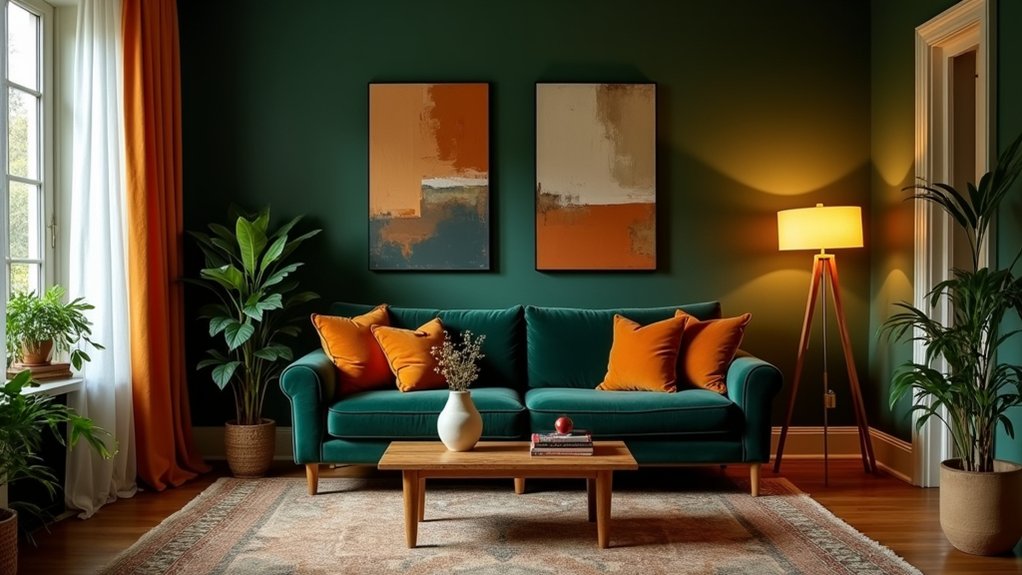

Leave a Reply